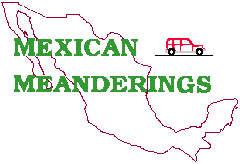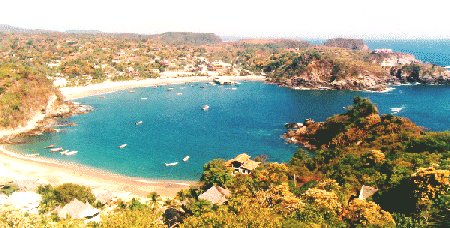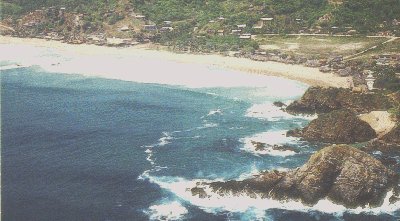Puerto Angel,
From the Sep/Oct 1995 issue No. 25 of the Mexican Meanderings Newsletter. |

|
Puerto Angel,
From the Sep/Oct 1995 issue No. 25 of the Mexican Meanderings Newsletter. |

|
![]() You do not get to the Port of the Angel by accident it is not really on the way to anywhere. And regardless of whether you arrive on Oaxaca's Pacific Coast by land or by air, you must still go by road to Pochutla.
You do not get to the Port of the Angel by accident it is not really on the way to anywhere. And regardless of whether you arrive on Oaxaca's Pacific Coast by land or by air, you must still go by road to Pochutla.
![]() Pochutla is a dusty and thriving cross-roads town (two banks, two gas stations, a Monday market and some 25,000 souls) where travelers from Acapulco and Puerto Escondido (west), Oaxaca city (north), Huatulco, Salina Cruz and Juchitán (east) mingle with those arriving from or continuing south to Puerto Angel. Some sources describe Pochutla as south of Puerto Escondido, but don't try that - the Pacific Ocean is large and wet.
Pochutla is a dusty and thriving cross-roads town (two banks, two gas stations, a Monday market and some 25,000 souls) where travelers from Acapulco and Puerto Escondido (west), Oaxaca city (north), Huatulco, Salina Cruz and Juchitán (east) mingle with those arriving from or continuing south to Puerto Angel. Some sources describe Pochutla as south of Puerto Escondido, but don't try that - the Pacific Ocean is large and wet.
![]() We chose to take the five hour bus ride down from Oaxaca. The last three hours through the mountains were wonderfully exciting both visually and physically (you might want to bring your motion-sickness pills). On arrival, ask at the Pochutla station where to catch the Puerto Angel bus, which leaves every twenty minutes or so. Or bargain with one of the omnipresent taxi drivers. We opted to share a taxi with a couple of rather ragged male German backpackers who were headed to the beach at Zipolite.
We chose to take the five hour bus ride down from Oaxaca. The last three hours through the mountains were wonderfully exciting both visually and physically (you might want to bring your motion-sickness pills). On arrival, ask at the Pochutla station where to catch the Puerto Angel bus, which leaves every twenty minutes or so. Or bargain with one of the omnipresent taxi drivers. We opted to share a taxi with a couple of rather ragged male German backpackers who were headed to the beach at Zipolite.
![]() The six mile ride from Pochutla was nothing short of stimulating. The narrow paved road wound blindly through high dunes, and our driver seemed obsessed with the idea that time was money. We gladly and thankfully bid him adiós in downtown Puerto Angel.
The six mile ride from Pochutla was nothing short of stimulating. The narrow paved road wound blindly through high dunes, and our driver seemed obsessed with the idea that time was money. We gladly and thankfully bid him adiós in downtown Puerto Angel.
![]() Having arrived without hotel reservations and little advance knowledge of the town, we sought out the "tourist agency" noted as a place where, for a few pesos per hour, one could leave bags while seeking accommodations. But first things first! It was time to relax and quaff a cold one (although it was early afternoon, my stomach still wasn't yet ready for solid food) while we studied "downtown" Puerto Angel and the surroundings.
Having arrived without hotel reservations and little advance knowledge of the town, we sought out the "tourist agency" noted as a place where, for a few pesos per hour, one could leave bags while seeking accommodations. But first things first! It was time to relax and quaff a cold one (although it was early afternoon, my stomach still wasn't yet ready for solid food) while we studied "downtown" Puerto Angel and the surroundings.
![]() Fortunately a palapa-roofed beach restaurant was right at hand, one of several offering cold beer, mariscos (shellfish), disinterested waiters and welcome shade from the midday sun. A block to the east was the pier we had caught a glimpse of from the taxi. Westward along the curved and dusty main street (known somewhat pretentiously as Bulevar Virgilio Uribe) lay much of the rest of the town. Some fifty yards on was a small Naval base. Landward was the excellent Villa Florencia restaurant, the market, a few small tiendas (shops) and the entrance to several hotels. Virtually all hotels are up the hill - you have to work to get to them.
Fortunately a palapa-roofed beach restaurant was right at hand, one of several offering cold beer, mariscos (shellfish), disinterested waiters and welcome shade from the midday sun. A block to the east was the pier we had caught a glimpse of from the taxi. Westward along the curved and dusty main street (known somewhat pretentiously as Bulevar Virgilio Uribe) lay much of the rest of the town. Some fifty yards on was a small Naval base. Landward was the excellent Villa Florencia restaurant, the market, a few small tiendas (shops) and the entrance to several hotels. Virtually all hotels are up the hill - you have to work to get to them.
![]() Historically, Puerto Angel is almost a cipher. Meager indications suggest pre-classic occupation (sometime prior to 600 A.D.) along the coast from here eastward toward Salina Cruz and Juchitán. Mayan and later Zapotec and Mixtec influence is suggested and is reasonable. However, no Tulums nor Monte Albáns have come to light. In view of colonial shipping activity along the coast and in nearby Huatulco and Puerto Escondido, it seems very probable that the well-protected bay of Puerto Angel might have attracted some pirate layovers, although there is nary a piece-of-eight nor doubloon to confirm this.
Historically, Puerto Angel is almost a cipher. Meager indications suggest pre-classic occupation (sometime prior to 600 A.D.) along the coast from here eastward toward Salina Cruz and Juchitán. Mayan and later Zapotec and Mixtec influence is suggested and is reasonable. However, no Tulums nor Monte Albáns have come to light. In view of colonial shipping activity along the coast and in nearby Huatulco and Puerto Escondido, it seems very probable that the well-protected bay of Puerto Angel might have attracted some pirate layovers, although there is nary a piece-of-eight nor doubloon to confirm this.
![]() One interesting story concerns a Danish botanist who arrived in the area shortly after 1840 to collect then unknown plants. He was surprised to find an archaic form of Danish being spoken by some of the inhabitants. Upon investigation, he learned that several generations earlier a Danish-manned vessel had foundered on the coastal rocks. The surviving sailors forsook the sea and settled in the area. Naturally they married local belles and set about teaching them and their children a language they understood Danish.
One interesting story concerns a Danish botanist who arrived in the area shortly after 1840 to collect then unknown plants. He was surprised to find an archaic form of Danish being spoken by some of the inhabitants. Upon investigation, he learned that several generations earlier a Danish-manned vessel had foundered on the coastal rocks. The surviving sailors forsook the sea and settled in the area. Naturally they married local belles and set about teaching them and their children a language they understood Danish.
![]() It wasn't until the mid 1800s that Benito Juárez, then 0axaca's native son president of Mexico, decreed that a port should be created here primarily for the shipment of coffee grown in the nearby hills. The town prospered for a while, but with the advent of trucking and increased access to other ports, hard times descended. Some time in this century, a light cargo pier was constructed. A 1988 publication speaking to retirement in Mexico states that it is a "...dock suitable for cruise ships..." but I have difficulty visualizing this, even after some help from the juice of the agave plant. Basically, only the fishing and the lure of uncrowded beaches remains.
It wasn't until the mid 1800s that Benito Juárez, then 0axaca's native son president of Mexico, decreed that a port should be created here primarily for the shipment of coffee grown in the nearby hills. The town prospered for a while, but with the advent of trucking and increased access to other ports, hard times descended. Some time in this century, a light cargo pier was constructed. A 1988 publication speaking to retirement in Mexico states that it is a "...dock suitable for cruise ships..." but I have difficulty visualizing this, even after some help from the juice of the agave plant. Basically, only the fishing and the lure of uncrowded beaches remains.
![]() The charm of the Puerto Angel of today is found mainly in
its size (or lack thereof), its unsophisticated character (no discos),
The charm of the Puerto Angel of today is found mainly in
its size (or lack thereof), its unsophisticated character (no discos),
 | |
|
Playa Panteón in the foreground. |
|
 | |
|
|
The above article is from the newsletter Mexican Meanderings, published 6 times per year by
|
Southwind Information Services |
Co-Editors: Subscriptions: $18 per year (USA) Copyright |
Other articles from the Mexican Meanderings newsletter are: